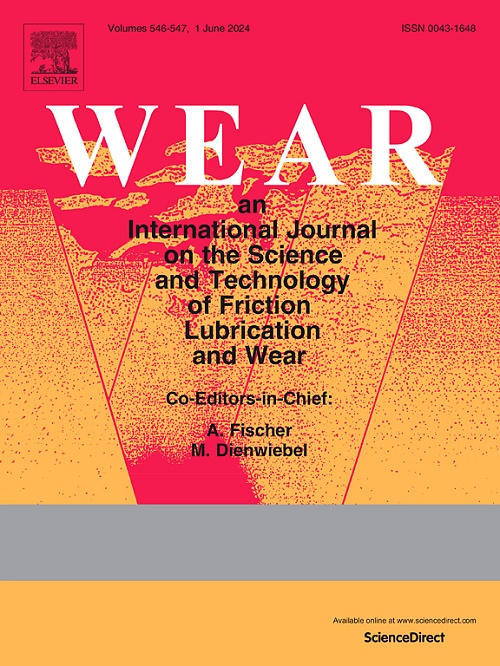AISI M2工具钢的粘结剂喷射增材制造:烧结参数对磨损性能的影响
IF 5.3
1区 工程技术
Q1 ENGINEERING, MECHANICAL
引用次数: 0
摘要
粘结剂喷射增材制造(BJAM)为制造高性能工具材料提供了巨大的潜力,但通过BJAM加工的AISI M2工具钢的性能在很大程度上仍未被探索。本研究通过系统地研究烧结温度(1270、1280和1300°C)和冷却方法(炉淬、空气淬火和水淬)对bjam加工的M2工具钢摩擦学性能的影响,弥合了这一空白。通过先进的表征技术,包括SEM/EDS图谱、原子力显微镜(AFM)和光学形貌,该研究检查了微观结构演变、摩擦学行为、碳化物分布(MC、M6C、M2C)及其在耐磨性中的作用。确定了四种主要的磨损机制,磨料、粘合剂、氧化和疲劳,每种机制都影响材料的失效模式。MC碳化物是磨料磨损的主要原因,M6C促进粘附,高温导致氧化磨损,疲劳磨损是由碳化物基体界面的微裂纹引起的。关键研究结果表明,后处理条件显著影响磨损性能。在1270℃下烧结60 min的水冷试样的摩擦系数和磨损体积损失最小,这是由于其微观组织更细,碳化物弥散均匀,硬度提高,从而减少了磨粒磨损。相反,较高的烧结温度会导致碳化物粗化、晶粒长大和磨损增加。该研究建立了BJAM加工参数与摩擦学性能之间的直接相关性,证明了其在模具应用中的可行性。研究结果为优化bjam加工的M2工具钢,提高其耐磨性和工业适用性提供了基础。本文章由计算机程序翻译,如有差异,请以英文原文为准。
Binder jetting additive manufacturing of AISI M2 tool steel: Investigating the influence of sintering parameters on wear behavior
Binder Jetting Additive Manufacturing (BJAM) offers significant potential for fabricating high-performance tooling materials, yet the behavior of AISI M2 tool steel processed via BJAM remains largely unexplored. This study bridges that gap by systematically investigating the effects of sintering temperatures (1270, 1280, and 1300 °C) and cooling methods (furnace, air, and water quenching) on the tribological performance of BJAM-processed M2 tool steel. Through advanced characterization techniques, including SEM/EDS mapping, Atomic Force Microscopy (AFM), and optical topography, the study examines microstructural evolution, tribological behavior, and carbide distribution (MC, M6C, M2C) and their role in wear resistance. Four dominant wear mechanisms, abrasive, adhesive, oxidative, and fatigue, are identified, each influencing the material's failure modes. MC carbides are primarily responsible for abrasive wear, M6C promotes adhesion, oxidative wear results from elevated temperatures, and fatigue wear arises from microcracks at carbide-matrix interfaces. Key findings indicate that post-processing conditions significantly impact wear performance. Water-cooled samples sintered at 1270 °C for 60 min exhibit the lowest coefficient of friction and wear volume loss, which is attributed to finer microstructure, uniform carbide dispersion, and increased hardness, which reduces abrasive wear. Conversely, higher sintering temperatures lead to carbide coarsening, grain growth, and increased wear. This study establishes a direct correlation between BJAM processing parameters and tribological properties, demonstrating its viability for tooling applications. The findings provide a foundation for optimizing BJAM-processed M2 tool steel for improved wear resistance and industrial applicability.
求助全文
通过发布文献求助,成功后即可免费获取论文全文。
去求助
来源期刊

Wear
工程技术-材料科学:综合
CiteScore
8.80
自引率
8.00%
发文量
280
审稿时长
47 days
期刊介绍:
Wear journal is dedicated to the advancement of basic and applied knowledge concerning the nature of wear of materials. Broadly, topics of interest range from development of fundamental understanding of the mechanisms of wear to innovative solutions to practical engineering problems. Authors of experimental studies are expected to comment on the repeatability of the data, and whenever possible, conduct multiple measurements under similar testing conditions. Further, Wear embraces the highest standards of professional ethics, and the detection of matching content, either in written or graphical form, from other publications by the current authors or by others, may result in rejection.
 求助内容:
求助内容: 应助结果提醒方式:
应助结果提醒方式:


